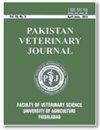家牛巴贝虫分离种的分子特征及系统发育分析
IF 5.4
3区 农林科学
Q1 VETERINARY SCIENCES
引用次数: 6
摘要
接收日期:修订日期:接受日期:在线发布日期:2019年6月15日至2019年9月25日至2020年1月6日巴贝虫病是一种由巴贝虫属原生动物寄生虫引起的主要蜱生疾病,自然界普遍存在,感染范围广泛的大型反刍动物。该研究旨在确定巴贝斯虫物种(B.bovis,B.bigemina)的本地分离株的存在——它们在旁遮普省(Narowal区)牛中的分子特征和系统发育关系。从选定地区七个村庄的200头疑似牛身上采集了血样。使用DNA唑、基因全试剂盒、手动法提取DNA,并使用特异性RLB和通用引物进行PCR扩增。使用Solis biodine试剂盒通过RT-PCR进行原生动物寄生虫的定量。在200份动物样本中,共有36份通过显微镜检查呈阳性。扩增PCR阳性样品(17),并分别获得具有特异性RLB和通用引物的强度为520bp和800bp的巴贝虫条带。将这17个样本送去测序,并使用Clustal W;建立了基于邻居连接法的生物编辑软件系统发育树。目前的研究报告了在巴基斯坦Narowal地区的大型反刍动物中存在B.bigemina,即18%(传统方法),并通过(分子表征)PCR(8.5%)和系统发育关系进行了证实。系统发育结果表明,本研究与双联巴贝虫菌株具有同源性。©2020 PVJ。保留所有权利本文章由计算机程序翻译,如有差异,请以英文原文为准。
Molecular Characterization and Phylogenetic Analysis of Babesia Species Isolated from Domestic Cattle
Received: Revised: Accepted: Published online: June 15, 2019 September 25, 2019 January 06, 2020 January 07, 2020 Babesiosis is a key tick born disease caused by the protozoal parasites belonging to the genus Babesia, cosmopolitan in nature and infecting enormous range of large ruminants. Study was intended to determine the presence of local isolates of Babesia species (B. bovis, B. bigemina) their molecular characterization and phylogenetic relationship in cattle (district Narowal) Punjab. Blood samples were collected from 200 suspected cattle, from seven villages of selected district. DNA was extracted by using DNA zole, Gene-all Kit, manual method and subjected to PCR for amplification using specific RLB and Universal Primers. Quantification of protozoan parasite was performed by RT PCR using Solis biodine kit. A total of 36 out of 200 animal samples, were found positive by microscopy. PCR positive samples (17) were amplified and bands of strength 520-bp and 800-bp with specific RLB and for universal primers respectively were obtained for Babesia species. These 17 samples were sent for sequencing and by using Clustal W; Bioedit software with Neighbor-joining method phylogenetic tree was established. Current study reported the presence of B. bigemina i.e. 18% (conventional method) in large ruminants of district Narowal, Pakistan, and confirmation by (molecular characterization) PCR (8.5%) and phylogenetic relationship. Phylogenetic results showed that our study has homology with Babesia bigemina strain. ©2020 PVJ. All rights reserved
求助全文
通过发布文献求助,成功后即可免费获取论文全文。
去求助
来源期刊

Pakistan Veterinary Journal
兽医-兽医学
CiteScore
4.20
自引率
13.00%
发文量
0
审稿时长
4-8 weeks
期刊介绍:
The Pakistan Veterinary Journal (Pak Vet J), a quarterly publication, is being published regularly since 1981 by the Faculty of Veterinary Science, University of Agriculture, Faisalabad, Pakistan. It publishes original research manuscripts and review articles on health and diseases of animals including its various aspects like pathology, microbiology, pharmacology, parasitology and its treatment. The “Pak Vet J” (www.pvj.com.pk) is included in Science Citation Index Expended and has got 1.217 impact factor in JCR 2017. Among Veterinary Science Journals of the world (136), “Pak Vet J” has been i) ranked at 75th position and ii) placed Q2 in Quartile in Category. The journal is read, abstracted and indexed internationally.
 求助内容:
求助内容: 应助结果提醒方式:
应助结果提醒方式:


